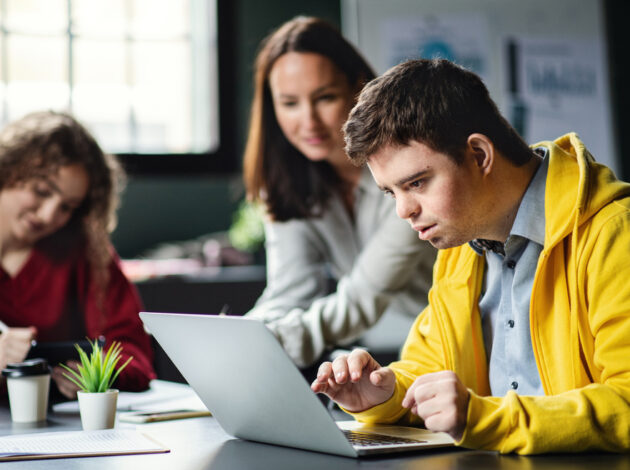What have we learned about the experience of disabled people?

Tomorrow (3 December) is the UN International Day for Persons with Disabilities. With the most recent estimates from the Department for Work and Pensions (DWP) putting the proportion of disabled people in the UK at 22% in 2021 (up from 19% a decade ago), this is a sizeable and very diverse group. Here, Helen Colvin and Josephine Foubert from the Office for National Statistics (ONS) look at some of the work we have been doing recently to give insight into the lives of disabled children and adults.
A cornerstone of our work is to provide high quality data reflective of the lives of all people in our society. Statistics for the Public Good and recommendations from the Inclusive Data Taskforce both drive our ambitions to improve the inclusivity of our data and recognise and address evidence gaps. By providing high quality data about disabled people, it allows for better development and evaluation of public policy, informs public understanding and decision making. This year we have provided new insights into the lives of disabled people and are planning ahead for more.
Disabled children
Starting with childhood, we recently spoke with young people with special educational needs and disabilities (SEND) to understand their own views about their learning experience. The IDTF noted that evidence about children and young people is often based on proxy views. The young people described the challenges they faced, and the strategies they adopted to manage difficult environments. One young teen, Finley, spoke of how holding and looking at a Hot Wheels toy car helped to settle him, for example. The participants in the study were full of ideas of how schools could encourage greater inclusion and be more responsive to young people’s needs, while also identifying many initiatives that were working well (“We have a dog that comes into school, it listens to everybody read,” said participant, Dan).
Parents and carers, meanwhile, highlighted the challenge of navigating ‘the system’ and getting the right educational support for their children. All talked of the need for great communication and empathy in what was, for some, a difficult process. These novel insights from the young people, parents and carers contribute to a better understanding of the educational experience and are now available to the Department for Education (DfE) which are undertaking a review of the special educational needs and disabilities (SEND) and alternative provision system in England.
Another piece of ONS analysis used new data to shine a light on vulnerable children who are often underrepresented in statistics. The piece exploring who are the children entering care? noted that a child being disabled was the reason given for 8% of boys and 4% of girls entering care. In a further 2% of cases, the reasons given for a young person entering care was because a parent was disabled.
Differences among disabled people’s experiences
The barriers and challenges disabled people face vary considerably. The IDTF recommendations emphasised the value of undertaking qualitative research to enable a more comprehensive understanding of the needs of disabled people. Talking to disabled adults this year about their experiences with activities, goods and services, we found that the barriers and challenges disabled people face vary considerably. For example, we saw how physical barriers such as narrow aisles, lack of stairs or accessible toilets could require significant preparation for disabled people or deter people from going out. For others, digital design was a barrier to accessing information or shopping online: “There’s no option for screen readers…everything is hidden in really weird awkward places. Like the user interface and user experience is not optimised at all. Things like that make it very hard for me as a consumer to actually purchase things”. Participants also suggested solutions for improving the inclusiveness of activities, goods and services in the future.
We have also been developing our COVID-19 work to explore whether disabled people with different impairment types were differently affected by the coronavirus pandemic. This enabled us to report for the first time on deaths involving coronavirus for those with a hearing, vision or dual-sensory impairment in addition to our existing work by self-reported disability.
The life stage at which someone becomes disabled can also make a significant difference to their experience and their social and economic circumstances. The lived experience of someone disabled from birth or early childhood is likely to be different from someone who becomes disabled much later in life, perhaps when they have completed their formal education and are well established in the labour market.
Disabled people and work
One of the key issues of this year has been changes in the labour market post-COVID. There’s been a lot of media coverage about older workers in particular. leaving their jobs. The survey we conducted especially to look at this issue shows that those over-50s who left work since the pandemic and had not returned were more likely to have a physical or mental health condition or illness (51%) than those who left since the pandemic but had since returned to work (43%).
Among those who had a “condition or illness lasting 12 months or more”, one in four (24%) said their condition or illness reduces their ability to carry out day-to-day activities a lot. This was true even for 10% of those who had left work since the pandemic but had since returned.
Increases in the cost of living may be behind the return to work for some people despite illness. We have been tracking the impact of cost of living increases on households and even back in the June to September period, over half (55%) of disabled adults reported finding it difficult to afford their energy bills. This compared with 40% of non-disabled people and a similar disparity was seen among those finding it difficult to afford their rent or mortgage: 36% of disabled people, compared with 27% of non-disabled people.
Planning ahead for Census 2021 analysis
With the release of Census 2021 data, we will be producing new insight into the lives of disabled people across England and Wales. For the first time we will have data on the whole population measuring disability against the Equality Act (2010) definition of disability. Summary data published on January 19th 2023 will be followed by detailed insights into the number of disabled people across the population exploring, among other things, disability by deprivation and understanding intersections between disability and other protected characteristics. We will also be able to address particular evidence gaps such as characteristics of disabled people living in communal establishments, variation in prevalence across local authorities and disabled children. We’ve set out our initial research plans which will be followed by further research utilising the benefits of new linked data opportunities.
Information from the census will help government and local authorities plan and fund local services to enhance the lives of disabled people. It will also enable individuals and third sector organisations to recognise and support the needs of people in their areas and help to hold decision makers to account.
Recognising and accommodating needs
We recognise that the statistics relating to disabled people appear stark and the issues complicated. In the qualitative work mentioned above, we heard about the barriers participants face and the workarounds they had devised to navigate them. The message to policy makers and providers of commercial and public services was clear: greater flexibility is needed if disabled people’s differing needs are to be recognised and accommodated.
Dozens of examples were given, from the sensory overload experienced by one participant going to the hair salon to the changes made to supermarket shelves that confused and disorientated another.
We hope the insights we provide through these and many other pieces of analysis are contributing to a greater awareness of, and action towards, the things that can make our society more accessible to disabled people.

Helen Colvin is joint lead for Census and Disability Analysis at the ONS

Josephine Foubert is joint lead for Census and Disability Analysis at the ONS